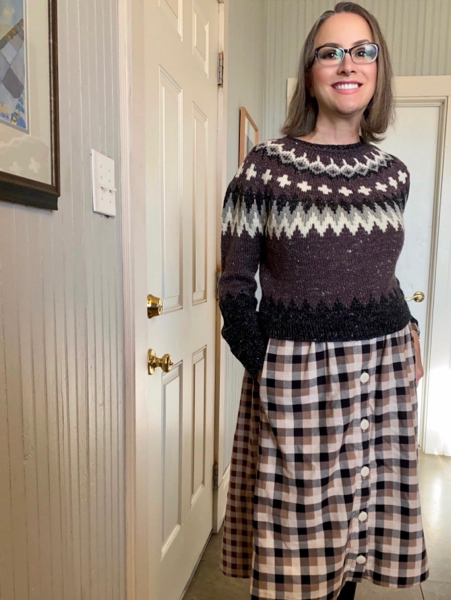For my last sewing project of the year, it is appropriate that I chose a fabric that I had been wanting for the entire year. Each time I looked at those photos online, I tried to vanquish my enthusiasm for them. Whether my reasoning was "Too bright"; "Too childish"; "Can't tell how it feels"; it was all no avail. I bought 1 1/2 yards of the daisy floral printed stretch rayon jersey knit in Earth/Orange/Mustard/Gold, 49" wide, for $25.50 from Fabrics and Fabrics and I am so glad I did.
It made a perfect first try of Vogue 8952, view B, size M. After testing several stretch stitches, I used a narrow zig zag (10/1.5/1.0) and the walking foot. Although I basically followed the instructions, I changed the order of construction, sewing in the sleeves before the cowl neck collar to avoid an extra change of thread.I chose a contrasting ribbed knit for the collar, not only because I was a little short of fabric but also because the print on this fabric gives it an obvious right side. At the time, I didn't realize that the collar is doubled to the inside after it is sewn on, so no wrong side shows. However, the collar is only tacked down in the back. The right side on the ribbed knit is not as obvious and will make a better collar in case the collar doesn't stay right side out all the time. The collar is all one piece, sewn together with a flat fell seam. Although the fabric has stretch, straight stitch is all that is needed for this flat fell seam since the seam has no stress on it that would require stretch. The technique I used was to stitch the seam with one allowance longer than other, wrong sides together, then fold the longer seam allowance over and topstitch it down. After the collar is attached, it is topstitched down with a straight stitch. That should prevent the neckline from stretching out too much.
The sleeves and top were both hemmed 1" shorter by cutting off 1" and then turning under 5/8" for the double needle hems. The length is a little long for my style, but it won't show once it is tucked in or worn under a skirt or jumper. It can always be shortened, so best to leave it long for now. (Note: It wouldn't hurt to alter both hem and sleeves in the pattern to remove 1" of length.
Ahem -- Ok, brace yourself, it is a lot of print. Sorta my fireworks for the day. This fabric is wonderfully soft and suprisingly thick, truly quality material. Since it may stretch, as my other rayon knits have done, it must be dried and stored carefully.Regarding the pattern, I like it. Overall, I am happy with the fit and would make this pattern again. If I do, I need to remember to do 3/8" seams between notches at waist if I want the same fit. I was a little put off by the points on the sides of this view, but they were surpisingly easy to sew and don't look bad. Most likely, no one will see them as I will probably be tucking this top in, wearing it under a cardigan, or under a jumper. It can use a little plain contrast. It will work well to liven up my dull skirts and jumpers, though.
Here's the side point:Eventually, I hope to try all three views of this pattern. Toward this goal, I made View A, the raglan with the banded neckline in an ochre rayon ribbed knit. I was excited to purchase this fabric because the color and fiber content were to my taste. I bought 2 yards of a 61" wide ribbed knit, 96% rayon 4% spandex, from Hobby Lobby (hand wash, cold, lay flat to dry, do not iron). It was on sale 66% off, total $10.19. My excitement stemmed from my favorable experience with wearing rayon knits and from my plan to work more brown into my wardrobe. Brown is terribly hard to find in the fabric world! Once I started handling it, I became concerned that the fabric is a bit too thin. However, it all went together without mods until the hem. It was too long for the skirt I plan to wear with it. I cut off 4" and recut it to the same lines as a RTW top I had purchased from Gap. I am hemming the curved bottom and the sleeves with the visible hem stitch set on 5 and 3.5, making for a very nice and stretchy hem.
In spite of the fact that the raglan is too roomy in the armholes and has that dumb dart at the shoulder that I don't see in RTW raglans, I really like wearing this top. There is still View C to make, but I am hesitant to try the dolman because it is normally harder to cut out.











